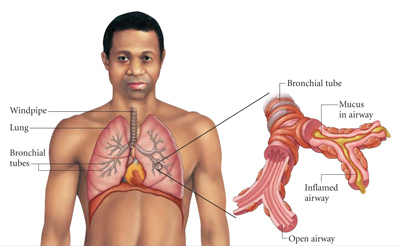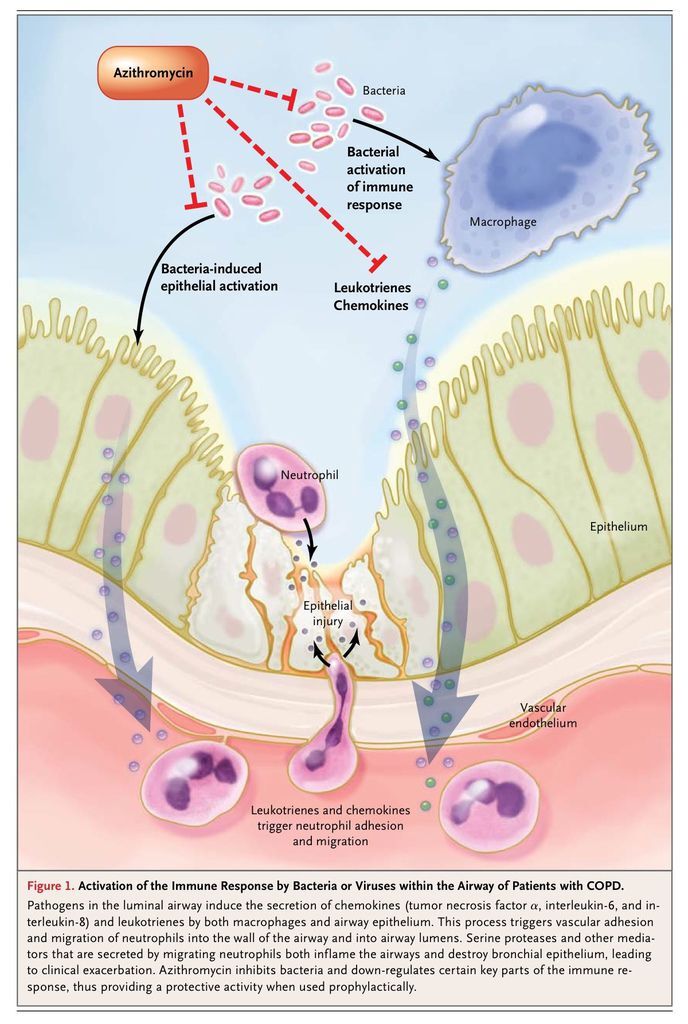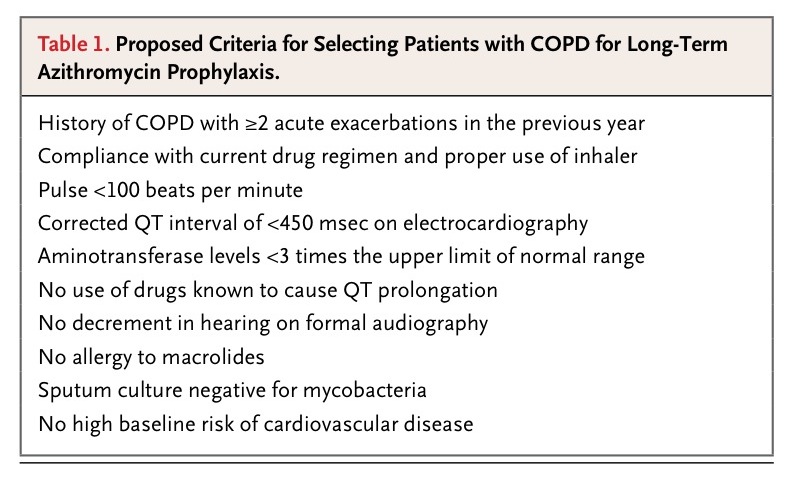
N Engl J Med 2012; 367:340-347July 26, 2012
Richard P. Wenzel, M.D., Alpha A. Fowler, III, M.D., and Michael B. Edmond, M.D., M.P.H., M.P.A.
This Journal feature begins with a case vignette that includes a therapeutic recommendation. A discussion of the clinical problem and the mechanism of benefit of this form of therapy follows. Major clinical studies, the clinical use of this therapy, and potential adverse effects are reviewed. Relevant formal guidelines, if they exist, are presented. The article ends with the authors' clinical recommendations.
A 55-year-old man presents with a history of recurrent exacerbations of chronic obstructive pulmonary disease (COPD) during the past year. These episodes were characterized by increased shortness of breath, cough, and sputum production. The diagnosis of COPD was made 2 years previously. Pulmonary-function testing then revealed a forced expiratory volume in 1 second (FEV1) of 50% of the predicted value after bronchodilator inhalation, with a ratio of FEV1 to forced vital capacity (FVC) of 60%. The patient had a 30-pack-year smoking history but stopped smoking after chronic lung disease was diagnosed. On the current visit, he is afebrile and has a resting pulse of 84 beats per minute. A careful review confirms that he is knowledgeable about proper inhaler use and that he is compliant with his medications, which include maintenance therapy with salmeterol and fluticasone as well as albuterol plus ipratropium as needed for intermittent therapy for increased dyspnea. His physician recommends the use of azithromycin at a dose of 250 mg daily to reduce the frequency of acute exacerbations.
THE CLINICAL PROBLEM
An estimated 24 million persons in the United States have COPD on the basis of lung-function testing.1 Globally, COPD is the fourth leading cause of death,2 and in the United States it is the third most common cause of death and chronic complications.3
The average person with COPD has one to two acute exacerbations each year, with wide variation from patient to patient.4 In 2000 in the United States, 726,000 patients were hospitalized with acute exacerbations of COPD.1 During an acute exacerbation, antibiotics are generally administered for 5 to 10 days,5 creating a national burden of 120 million to 480 million antibiotic-days annually. The median hospital stay per exacerbation has been estimated at 9 days.6 In a 2007 Canadian study, the median cost of a hospital stay after an acute exacerbation of COPD was $9,557 (Canadian dollars).7
Acute exacerbations of COPD requiring hospitalization are associated with a 30-day rate of death from any cause of 4 to 30%.6 A study in Sweden showed an all-cause mortality of 26% at 30 days and of 69% at 3 years.8 Acute exacerbations also accelerate the progressive decline in lung function associated with COPD. Overall, the FEV1 falls by approximately 33 ml per year in patients with COPD.4 Each acute exacerbation increases the rate of decline by an additional 2 ml per year4and by up to 7 ml per year in smokers.6
PATHOPHYSIOLOGY AND EFFECT OF THERAPY
COPD is characterized by chronic airway inflammation resulting in increased mucus production and airway ciliary malfunction. The inflammatory process leads to destruction of respiratory bronchioles, parenchymal loss, and thickening of the vascular wall.9,10 With progressive limitation of airflow and decrements of both oxygen and carbon dioxide exchange, elevated pulmonary-artery pressures and eventually right ventricular hypertrophy and right heart failure (cor pulmonale) develop in some patients.11 Expiratory airflow obstruction is a prominent clinical feature and the key measure of disease progression.
Exacerbations of COPD have been shown to coincide with acute respiratory viral infections, including those with picornaviruses, influenza virus, and respiratory syncytial virus.12 At the same time, the sputum of patients with COPD is colonized with bacteria, often with newly acquired strains of known pathogens such as Streptococcus pneumoniae, Haemophilus influenzae, and Moraxella catarrhalis.13 Lines of evidence linking bacteria to acute exacerbations include the finding of new bacterial strains in 33% of patients seen in clinics for exacerbations,13 a correlation between bacterial colonization of lower airways and elevated levels of inflammatory mediators (e.g., tumor necrosis factor α, interleukin-6, and interleukin-8),14-16 a correlation between substantial bacterial infection of small airways and acute exacerbations,17-20 and improved outcomes after antibiotic treatment.21
Members of the macrolide class of antibiotics — including erythromycin, clarithromycin, and azithromycin — inhibit bacterial RNA-directed protein assembly by binding to the 50S subunit of bacterial ribosomes.22 In addition to their antimicrobial efficacy, macrolides have been shown to have antiinflammatory and immune-modulating effects.23 It has been shown that these drugs decrease the production of cytokines in the lungs24 (FIGURE 1 Activation of the Immune Response by Bacteria or Viruses within the Airway of Patients with COPD.). In most clinical trials, 90% or more of patients with acute exacerbations of COPD who were treated with macrolides had increased rates of early clinical response.25

CLINICAL EVIDENCE
A recent large clinical trial by Albert et al.26 involving 1142 volunteers examined the hypothesis that daily administration of 250 mg of azithromycin for 1 year would reduce the frequency of acute exacerbations of COPD. Among the participants, 570 received azithromycin and 572 received placebo. Among patients in the azithromycin group, the median time to the first acute exacerbation was increased by 92 days (from 174 days in the placebo group to 266 days in the azithromycin group). The frequency of exacerbations was 1.48 per year in the azithromycin group versus 1.83 in the placebo group (hazard ratio in the azithromycin group, 0.73; 95% confidence interval [CI], 0.63 to 0.84; P<0.001). Quality of life, as measured by the St. George's Respiratory Questionnaire, improved to a greater degree in the azithromycin group than in the placebo group. There was no significant difference in overall mortality between the groups. Patients with risk factors for adverse effects of azithromycin were excluded from the trial. Potential participants were not enrolled if they had known hearing impairment (as documented on audiometric testing) or a corrected QT (QTc) interval of more than 450 msec or if they were using other medications (except amiodarone) that could prolong the QTc interval. Patients with a resting pulse rate of more than 100 beats per minute were also excluded.
In another long-term, placebo-controlled clinical trial examining macrolide antibiotics in the prevention of acute exacerbations of COPD involving 109 patients, erythromycin was the active drug, given at a dose of 250 mg twice daily for 1 year.27 The primary outcome was the number of moderate or severe exacerbations (as treated with systemic glucocorticoids, antibiotics, or hospitalization). The rate ratio for exacerbations in the erythromycin group was 0.65 (95% CI, 0.49 to 0.86; P=0.003).
CLINICAL USE
All patients with the diagnosis of COPD should be treated according to the recommendations in current guidelines. Recent updates to the American College of Physicians guidelines28 and the Global Initiative for Chronic Obstructive Lung Disease (known as GOLD) report29 make broadly similar recommendations for COPD management. These include smoking cessation, enrollment in a pulmonary rehabilitation program, and the use of evidence-based medications, including long-acting inhaled beta-agonists, long-acting inhaled anticholinergic agents, and inhaled glucocorticoids. It is also important to assess and emphasize proper inhaler use and compliance with all aspects of therapy.
A patient who continues to have frequent acute exacerbations despite guidelines-based treatment is a potential candidate for prophylactic use of azithromycin

(TABLE 1 Proposed Criteria for Selecting Patients with COPD for Long-Term Azithromycin Prophylaxis.). In our view, a patient should have had at least two episodes of acute exacerbation in the previous year to be considered for such therapy, both to provide a baseline against which to assess clinical response and to limit overuse of azithromycin in the wider population of patients with COPD. Patients with any of the exclusion criteria that were used in the trial by Albert et al.26should not take azithromycin. The resting pulse rate should be less than 100 beats per minute, and the patient should undergo electrocardiography to rule out a QTc of more than 450 msec and formal audiography to exclude any hearing deficit. In addition, the patient should not be taking any drug that is known to increase the QTc interval. Furthermore, since azithromycin is an inhibitor of the cytochrome P-450 enzyme CYP3A4, it should not be used if the patient is taking any drug that is metabolized by that enzyme.
The dose of azithromycin that was used in the clinical trial was 250 mg per day. In earlier pharmacokinetics studies of azithromycin, Foulds et al.30 found that after the administration of 250 mg of azithromycin, the usual serum peak level was 0.4 μg per milliliter. However, with repeated daily administration, lung-tissue levels were usually 75 times as high, and tissue levels persisted even after serum levels declined. Furthermore, in a murine model of lung infection, Retsema et al. found that azithromycin was bactericidal and that the effect correlated with lung-tissue levels of the drug.31 Tissue levels of azithromycin are sufficient for a bactericidal effect after administration three times a week or a larger weekly dose alone. In addition, macrolide prophylaxis has been used successfully in other conditions in regimens ranging from once daily to once weekly to three times weekly (see below). Thus, we do not think that daily administration is necessary, and even though there are no specific data to support this approach, we favor a regimen consisting of 250 mg administered on Monday, Wednesday, and Friday.
Dose adjustment is not needed for renal dysfunction. However, because macrolides are metabolized in the liver, we suggest not using azithromycin if the patient has moderate or severe liver disease, as indicated by serum aminotransferase levels of more than three times the upper limit of the normal range. This suggestion is not based on published data but is recommended as a precaution.
In adherence to the protocol of the trial by Albert et al.,26 we suggest follow-up evaluations every 3 months, at which time all the initial screening, including audiography and electrocardiography, should be repeated. The physician should ask the patient about hearing problems, disequilibrium, and tinnitus, which might be signs of ototoxicity. In addition, since any antibiotic can select forClostridium difficile, the patient should be asked about diarrhea and other gastrointestinal symptoms.
The cost of generic azithromycin is $99 per 30 doses (www.drugstore.com). Thus, the annual cost of prophylaxis would be $1,188 with daily azithromycin use or $515 with use three times weekly. If approximately three patients need to be treated to prevent one annual exacerbation (as suggested by the results of the large clinical trial), the annual cost to prevent an exacerbation would be $3,564 (for daily administration) or $1,545 (for administration three times a week).
ADVERSE EFFECTS
There are three major categories of adverse effects that may be anticipated with yearlong use of azithromycin. These include ototoxicity, cardiac toxicity, and drug–drug interactions.
Hearing loss, disequilibrium, and tinnitus are potential adverse effects of macrolides.32-34 In the trial by Albert et al.,26 there was a 5% differential in hearing loss between the antibiotic-treatment group (25%) and the placebo group (20%). This 5% absolute difference is the best estimate of the hearing loss directly attributable to azithromycin with long-term use. Our review of the literature identified 25 cases of azithromycin-induced ototoxicity. Some of the patients in these studies were also taking drugs metabolized by cytochrome P-450, and in some patients the hearing loss was not reversible during the follow-up period.35-40
Macrolide antibiotics prolong the QTc interval by blocking a cardiac potassium channel called the human ether-a-go-go–related gene (HERG) channel.41 A prolonged QTc interval is associated with an increased risk of torsades de pointes, potentially resulting in ventricular fibrillation and sudden death. In a recent large retrospective cohort study, short-term use of azithromycin (5 days) was associated with an estimated 47 additional deaths from cardiovascular causes per 1 million antibiotic courses, as compared with amoxicillin.42 Since torsades de pointes is an unusual event, screening patients for a QTc interval of more than 450 msec and excluding them from azithromycin prophylaxis may help minimize the risk (Table 1). Nevertheless, we suggest avoiding the use of azithromycin in patients with a high risk of baseline cardiovascular disease. Such patients include those with congestive heart failure, cerebrovascular disease, and peripheral vascular disease.42
Macrolides also inhibit the CYP3A4 isoenzyme, thus increasing serum levels of other drugs metabolized by this enzyme (Table 1). Azithromycin is a weaker inhibitor than erythromycin or clarithromycin in vitro,43 but caution is still justified on the basis of individual variability in CYP3A4 metabolic activity. Examples of drugs with which potentially important interactions may occur include the statins, resulting in an increased risk of rhabdomyolysis44; warfarin, resulting in an increase in the international normalized ratio44; and amiodarone, resulting in an increased risk of QTc prolongation and ventricular arrhythmias.45
AREAS OF UNCERTAINTY
The development of antibiotic resistance with prolonged azithromycin prophylaxis is an issue of major concern but one with uncertain clinical implications. In the trial by Albert et al.,26nasopharyngeal swabs were obtained for assessment of bacterial colonization and antibiotic resistance at the time of enrollment and every 3 months thereafter. The rates of first-time colonization were lower in the azithromycin group than in the placebo group, but the new colonizing organisms were much more likely to be resistant to macrolide antibiotics (81%, vs. 41% in the placebo group). The trial was not large enough and did not have a sufficient duration to permit an assessment of the clinical consequences of this resistance pattern.
Long-term macrolide prophylaxis has been used in a number of other disorders. These conditions include diffuse panbronchiolitis (a chronic inflammatory disease of the bronchioles seen primarily in Japan, China, and Korea),46-48 cystic fibrosis,49-53 and bronchiectasis.54,55 It has also been used in the prevention of Mycobacterium avium complex infection in patients with the acquired immunodeficiency syndrome and a CD4+ count below 50 cells per cubic millimeter.56 In at least some of these disorders (especially cystic fibrosis), macrolide prophylaxis has been associated with significant increases in the rate of antibiotic resistance but without apparent adverse consequences for the treatment of subsequent acute exacerbations.
A related concern is that of the wider spread of macrolide-resistant organisms from patients being treated prophylactically to the general population. In one study, in patients with COPD who received a macrolide antibiotic within 6 months after a follow-up culture, the rate of isolation of S. pneumoniae resistant to a macrolide in sputum (54%) was nearly four times that in unexposed controls (14%).57 In theory, close contacts and family members of patients with antibiotic-resistant strains could acquire the organism.
The wider spread of resistance could also be a problem for the management of other organisms for which macrolide antibiotics are used. Azithromycin is commonly administered to treat legionella and mycoplasma infections, but fluoroquinolones are well established as alternative agents for these pathogens. Of greater concern is the importance of macrolide therapy in the management of infections with nontuberculous mycobacteria, which can infect patients with COPD. Some experts are promoting the idea of screening patients with COPD for colonization with nontuberculous mycobacteria and withholding macrolide prophylaxis in those with positive sputum cultures (Fennelly K, Griffith D: personal communication). We concur with this recommendation (Table 1).
The two above-mentioned clinical trials evaluated the effects of a single year of macrolide prophylaxis, leaving unresolved the question of whether to continue long-term prophylaxis in patients with this chronic disease. The experience with long-term macrolide prophylaxis in patients with other diseases offers some reassurance that azithromycin can be continued after the first year. We would suggest discontinuing the drug if important adverse effects surface or if the number of exacerbations does not decrease during the first year of treatment. This may be especially likely among patients with advanced COPD, whose disease course is typically characterized by an increased number of exacerbations.58
Additional concerns relate to the risk of known long-term adverse events. Will hearing loss be additive, and will the rate of this adverse effect increase? Will QTc-related arrhythmias develop even if patients are carefully selected? Continued screening will be necessary during ongoing prophylaxis. Population-based studies should be carried out to examine success rates, adverse drug events, and the effect of antibiotic resistance after long-term prophylaxis with azithromycin.
It is unknown whether other antibiotics could be as effective as, or more effective than, azithromycin in patients with COPD. Clinicians treating pulmonary patients with long-term prophylaxis have primarily used macrolides. Of the available macrolides, azithromycin is the most studied and the one with the fewest adverse effects. Few other antibiotics have recently been studied for this purpose. In one trial, patients with stable COPD were randomly assigned to receive either moxifloxacin at a dose of 400 mg daily or placebo for 5 days every 8 weeks for 48 weeks. The mean exacerbation rate was 0.88 with moxifloxacin and 0.94 with placebo, a difference that was not significant.59 In our view, quinolones should not be preferred over macrolides for COPD prophylaxis, because they are so important for treating community-acquired pneumonia.
GUIDELINES
The use of azithromycin for the prevention of COPD exacerbations has not been endorsed by current expert guidelines. The GOLD report29 states that “a recent trial of daily azithromycin showed efficacy on exacerbation end points; however, treatment is not recommended because of an unfavorable balance between benefits and side effects.” A recent update to the American College of Physicians guidelines28 does not mention the use of prophylactic antibiotics.





 留言列表
留言列表
 線上藥物查詢
線上藥物查詢 